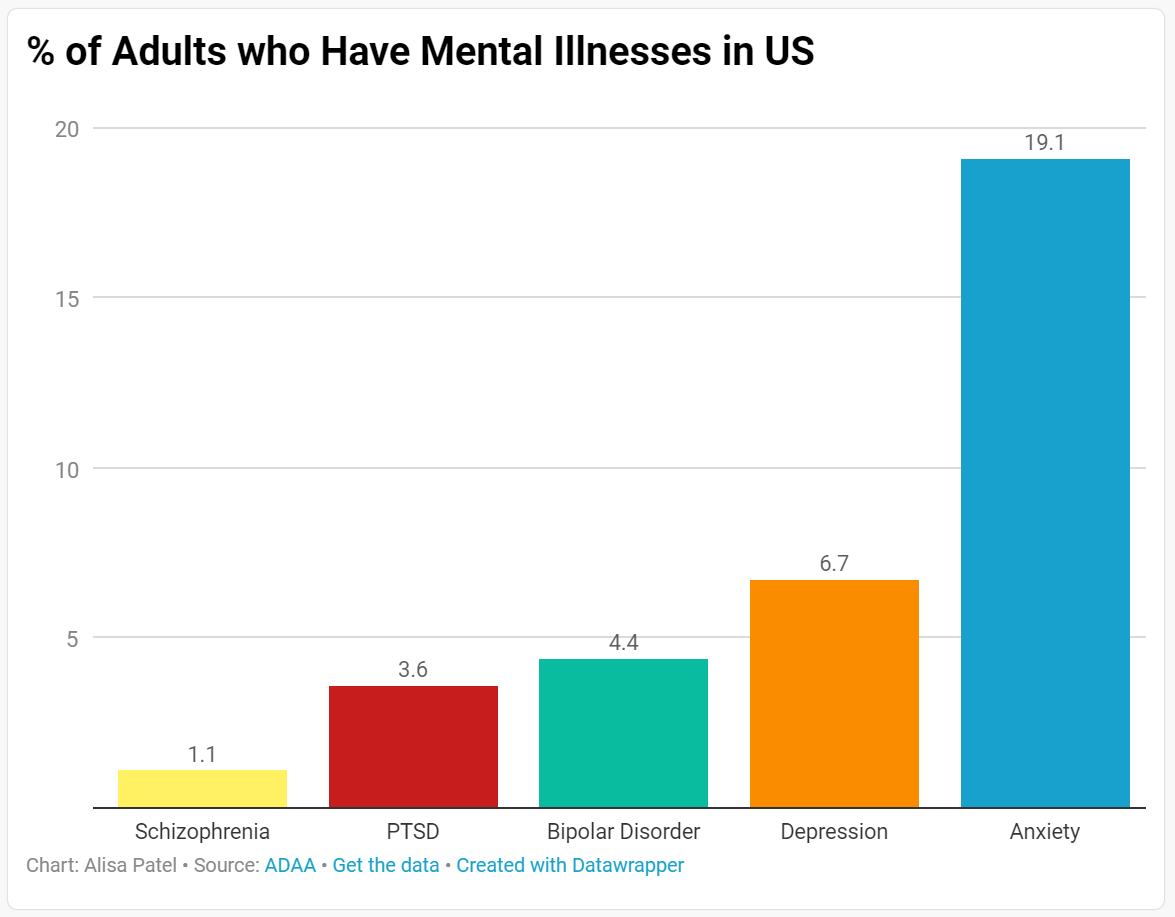Going to the Gym Can Lead to Improvements in Mental Health
In the United States, around 1 in 5 adults experience mental health issues. In 2017, that was about 46.6 million adults. According to the National Institute of Mental Health, mental health falls on a scales and ranges from mild to severe. Two general categories of mental health are Any Mental Illness (AIM) and Serious Mental Illness (SMI).

According to the National Institute of Mental Health, AIM can be defined as “a mental, behavioral, or emotional disorder. AMI can vary in impact, ranging from no impairment to mild, moderate, and even severe impairment.” The figures below show the percentage of adults who face AIM through different demographics such as sex, age, and race. The overall percentage of adults who have AIM is 18.9%.
In terms of age, the group that experiences mental health range from the ages 18-25 years old. These years are known to be when you grow the most in your life. Adults go through various phases during this time like entering college or the workforce. These stressful times can cause various adults to show symptoms of various mental health illnesses.
According to the National Alliance on Mental Illness (NAMI), 60% of adults with mental health did not receive mental health services last year. Lizzie Fernandez, a junior studying Health Promotions at American University and member of the Health Promotion and Advocacy Center (HPAC) adds that many people are apprehensive when it comes to talking about mental health and how to go about it. “During my office hours, students dealing with mental health come in and are nervous to discuss it. Since it is a touchy subject, awareness to how many people experience mental health needs to be increased. As well as ways in which to positively deal with your mental health.” According to Alayna Berkowitz, a psychologist and staff clinician at American University’s Counseling Center, many people facing mental health are constantly looking for ways to improve. “Many think that these ways are very costly and require therapy or counseling. However, there are some ways you can improve your mental health right now.”
Sam Moran, a junior student at American University, experiences anxiety. He explains it can be hard to find time to focus on your mental health, especially during peak school times. “I don’t really have time to try and improve my mental health. I know I should put it first, but I don’t know how well it would work compared to the current treatment I’m on now. In a study conducted with 50 participants at American University, 29 adults said they have mental health. Of those 29, 22 adults said they are willing to improve their mental health. The question is: how?
One common way that not many people realize is exercise. While many know that exercise can help with a lot of physical and health aspects such as obesity, diabetes, cancer, cardiovascular health, etc., many don’t realize that exercise releases a hormone that lead to improvements in mood. Improvements in mood can lead to overall better mental health. Fernandez states, “Going to the gym can help with mental health by boosting endorphins, the body’s natural neuropeptide that boosts mood and dulls pain.” Exercise increases the volume of specific brain regions. This leads to better blood supply that improves the delivery of oxygen and nutrients and an increase in neurohormones. An increase of blood circulation to the brain leads to an influence on the psychological reactivity to stress. Exercise creates various beneficial effects on mental health like distraction, self-efficiency, and social interaction.
The figure below shows the percent of US adults who have specific mental illnesses like depression, anxiety, bipolar disorder, schizophrenia, and posttraumatic stress disorder (PTSD). Since there are many different types of mental illnesses, different exercise affects them in different ways. Mental health illnesses are distinguished by a cognitive flexibility that creates bad habits such as repeating unhelpful behaviors, restricting the ability to process new information, and reducing the capacity to find new solutions to constant problems. Exercise increases the potential for cognitive flexibility by reducing the amount of stress by releasing endorphins. While the most common mental illness in US adults is anxiety, the correlation between exercise and anxiety is the lowest. Exercise affects anxiety by limiting the intensity of anxiety symptoms as well as how often they occur, temporarily. While exercise does affect anxiety, it positively affects depression the more. Exercise affects depression by changing the perspective you have on your self-image and self-esteem, releasing mood-boosting endorphins, and producing certain proteins.
According to NAMI, “Individuals living with serious mental illness face an increased risk of having chronic medical conditions. Adults in the U.S. living with serious mental illness die on average 25 years earlier than others, largely due to treatable medical conditions.” Awareness of the importance of treatment for adults experiencing mental illnesses needs to be increased. Especially when some treatments can be done independently, like exercise. Physical activity leads to various beneficial effects on different mental health illnesses like releasing endorphins (the body’s natural painkiller), reducing stress, allowing more cognitive flexibility, improving mood, and boosting the ability to sleep. All these effects, positively affect various mental illnesses like anxiety, depression, mood disorders, PTSD, etc.
Serena Thapa, a student at American University and employee of the AU Fitness Centers believes the gym fosters a space of interaction and motivation for personal goals, whether they be physical or mental related. “Everyone that walks into the facility has an intention. They either come in wanting to work on their fitness, blow off some steam, or simply just see friendly faces while they go on a light jog or walk on the treadmill. All and all, the gym allows individuals to be at ease and thus improve their mental health.”
